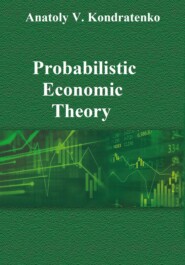По всем вопросам обращайтесь на: info@litportal.ru
(©) 2003-2025.
✖
Probabilistic Theory of Stock Exchanges
Настройки чтения
Размер шрифта
Высота строк
Поля
= 281.4 $/ton, q
= 51.9 ton/year.
Let us now turn to the question of calculating market prices and quantities within the framework of probabilistic economics. It is well known from the standard course of mathematical analysis that extrema of a multidimensional function should be defined as points on the corresponding surface in which the total differential of this function is 0. In our situation this condition leads to the following equation:
This equation is equivalent to the following two partial derivative equations:
In terms of S&D functions, this system is transformed as follows:
At this point it makes sense to introduce a new concept into theory, namely the concept of S&D market forces with such definitions:
In terms of market forces we can write the system of equations (1.25) more compactly as follows:
Obviously, this system of equations looks like a system of equality of S&D market forces at values of market prices and quantities. And it is similar to the system of forces equality at the static equilibrium point in classical mechanics. In other words, the system of economic equations (1.27) looks like a formulation of Newton's third law in classical mechanics. Substituting specific S&D functions from equations (1.16) and (1.20) into the system of equations (1.26), we obtain such simple and clear formulas for calculating market forces:
As we can see, all forces have become one-dimensional functions in this model. Then, using these equations, we obtain a very elegant system of two independent linear equations to determine market prices and quantities:
This system is so simple that you don't even have to solve it in the usual sense to get a very nice looking solution for market prices and quantities:
Thus, probabilistic market prices and quantities in a two-agent economy, when using factorized agent functions in the form of Gaussians, are determined by averaging the corresponding agent parameters, with the frequency parameters of the agents serving as weights in this averaging. The fundamental point here is that these two simple, and independent, algebraic formulas, which include only four buyer parameters (p
Вы ознакомились с фрагментом книги.
Приобретайте полный текст книги у нашего партнера:
Приобретайте полный текст книги у нашего партнера:







